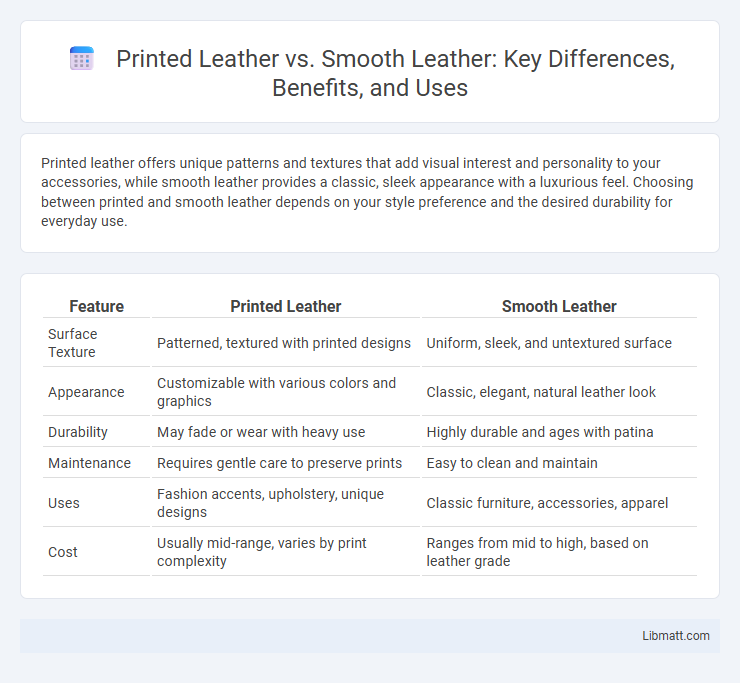Printed leather offers unique patterns and textures that add visual interest and personality to your accessories, while smooth leather provides a classic, sleek appearance with a luxurious feel. Choosing between printed and smooth leather depends on your style preference and the desired durability for everyday use.
Table of Comparison
| Feature | Printed Leather | Smooth Leather |
|---|---|---|
| Surface Texture | Patterned, textured with printed designs | Uniform, sleek, and untextured surface |
| Appearance | Customizable with various colors and graphics | Classic, elegant, natural leather look |
| Durability | May fade or wear with heavy use | Highly durable and ages with patina |
| Maintenance | Requires gentle care to preserve prints | Easy to clean and maintain |
| Uses | Fashion accents, upholstery, unique designs | Classic furniture, accessories, apparel |
| Cost | Usually mid-range, varies by print complexity | Ranges from mid to high, based on leather grade |
Overview of Printed Leather and Smooth Leather
Printed leather features intricate patterns or designs applied through stamping, embossing, or digital printing, enhancing aesthetic appeal and offering diverse style options. Smooth leather is characterized by a polished, uniform surface with minimal texture, prized for its sleek appearance and classic sophistication. Both types vary in durability and maintenance, with printed leather often requiring careful upkeep to preserve design integrity, while smooth leather offers easier cleaning and long-lasting finish.
Defining Printed Leather
Printed leather is leather that has been treated with patterns or designs using ink, foil, or embossing techniques to create visual textures or motifs on the surface. Unlike smooth leather, which maintains its natural grain and texture, printed leather often features elaborate graphics or vibrant colors that enhance its aesthetic appeal. These custom prints can replicate animal skins, geometric shapes, or abstract designs, making printed leather ideal for fashion, upholstery, and accessories seeking distinctive visual style.
Characteristics of Smooth Leather
Smooth leather features a uniform surface with a sleek, polished finish that enhances its durability and ease of maintenance. Its natural grain is tightly packed, providing a soft, supple texture and resistance to moisture and stains compared to printed leather. This type of leather is commonly used in high-end fashion and upholstery for its classic appearance and long-lasting quality.
Production Processes Compared
Printed leather undergoes an additional step where patterns or textures are embossed or printed onto the surface using techniques like digital printing, screen printing, or hot stamping, enhancing its aesthetic variation. Smooth leather involves minimal surface alteration, primarily focused on tanning, dyeing, and finishing to preserve its natural grain and soft texture. Both leather types start with the curing and tanning of hides, but printed leather requires precise surface preparation for pattern adhesion and durability, making its production slightly more complex.
Aesthetic Differences
Printed leather features intricate designs and patterns directly embedded into the surface, offering a visually dynamic and textured appearance that enhances fashion-forward styles. Smooth leather presents a sleek, uniform finish with a subtle natural grain that exudes classic elegance and timeless sophistication. The choice between printed and smooth leather significantly influences the overall aesthetic, with printed leather appealing to bold, statement-making preferences while smooth leather suits minimalist, refined looks.
Durability and Wear Resistance
Printed leather typically has a surface coating that can wear off more quickly under heavy use, making it less durable compared to smooth leather. Smooth leather, particularly full-grain or top-grain, offers superior wear resistance due to its natural, uncoated surface that can develop a patina over time. Therefore, for long-lasting durability and better resistance to abrasion, smooth leather is generally preferred over printed leather.
Maintenance and Care
Printed leather requires gentle cleaning with a soft cloth and mild soap to preserve the design, avoiding abrasive materials that can damage the print. Smooth leather benefits from regular conditioning with leather-specific creams to maintain its suppleness and prevent cracking. Understanding the distinct maintenance needs helps you extend the life and appearance of both printed and smooth leather products.
Popular Uses in Fashion and Design
Printed leather is widely favored in fashion for statement pieces such as jackets, handbags, and footwear, where vibrant patterns and textures create unique, eye-catching designs. Smooth leather remains a classic choice for timeless items like tailored jackets, belts, and shoes, offering versatility and an elegant, polished finish that complements formal and casual wear alike. Your selection between printed and smooth leather depends on the desired aesthetic, whether you seek bold, artistic expression or refined, minimalist style.
Environmental Impact
Printed leather typically involves additional chemical treatments and dyeing processes that increase water usage, energy consumption, and the release of volatile organic compounds (VOCs), thereby elevating its environmental footprint compared to smooth leather. Smooth leather production generally requires fewer processing steps, resulting in lower emissions and waste generation, making it a more sustainable choice. However, both types of leather share concerns related to livestock farming's carbon emissions and resource depletion, emphasizing the importance of responsible sourcing and eco-friendly tanning methods.
Choosing Between Printed and Smooth Leather
Choosing between printed and smooth leather depends on style preferences and intended use; printed leather offers unique textures and visual patterns ideal for fashion-forward designs, while smooth leather provides a classic, versatile look known for durability and ease of maintenance. Consider the environment where the leather will be used, as smooth leather often resists wear and stains better than printed options that may fade or crack over time. Selecting the right leather type requires balancing aesthetic appeal with functional longevity based on specific needs.
Printed leather vs smooth leather Infographic

 libmatt.com
libmatt.com